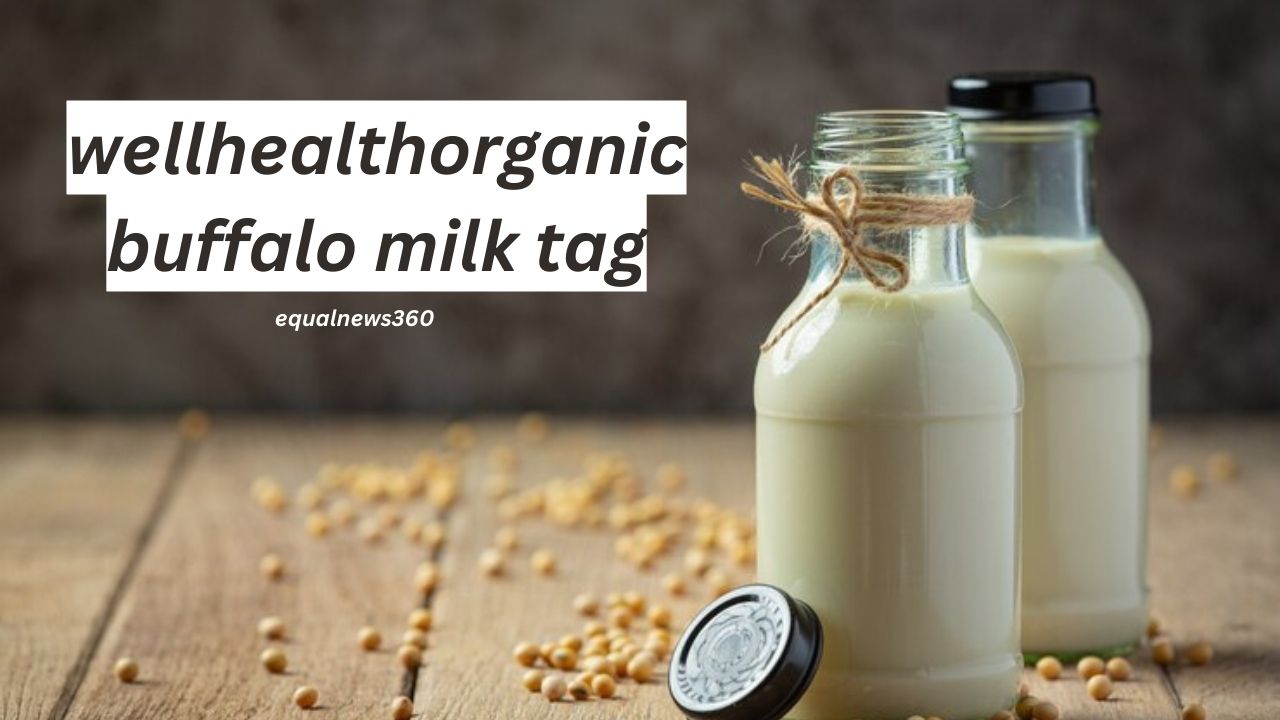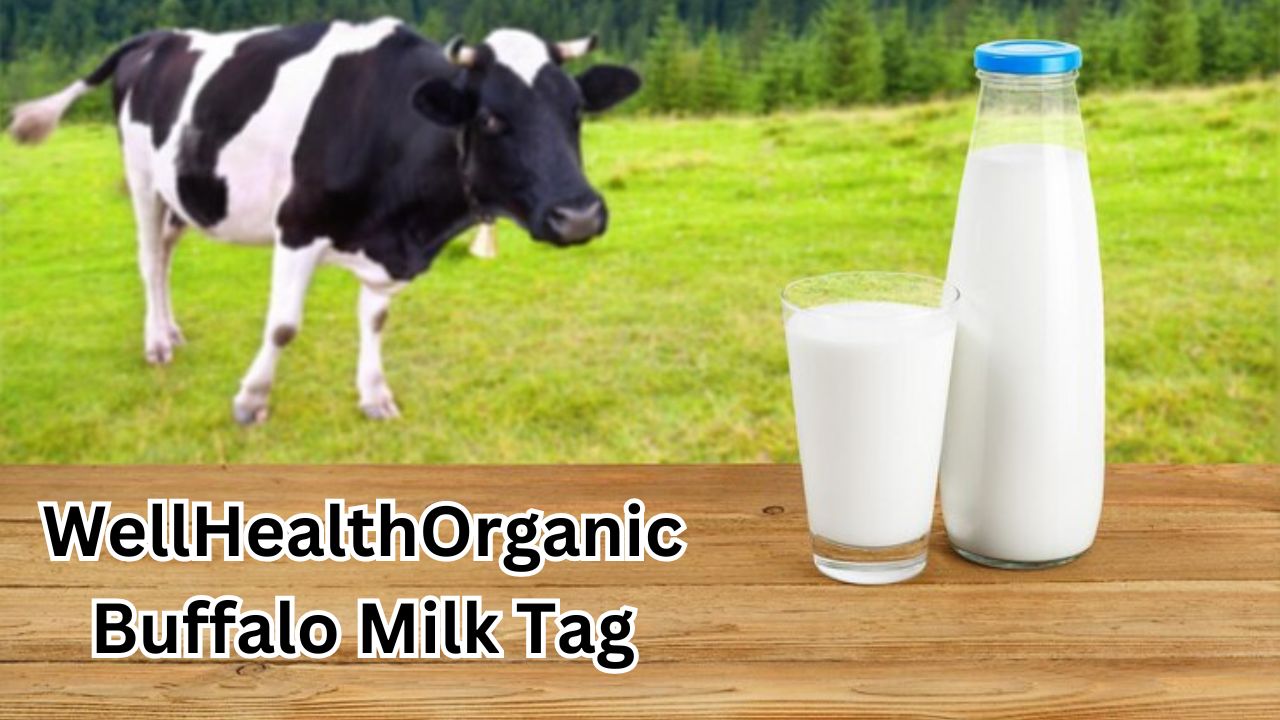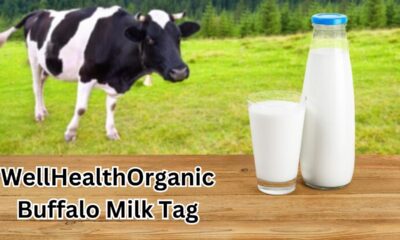HEALTH
wellhealthorganic buffalo milk tag
Published
5 months agoon
By
Saad
Welcome to the world of Wellhealthorganic, where we believe that nourishing your body with wholesome and organic products is the key to a vibrant and healthy life. Today, we are excited to dive into the topic of buffalo milk – a lesser-known gem in the dairy world that packs a punch when it comes to nutritional benefits. Get ready to discover why buffalo milk deserves its moment in the spotlight as we explore its unique properties, how Wellhealthorganic sources this liquid gold, and some delicious ways you can incorporate it into your culinary creations. So grab a glass of buffalo milk (or perhaps save it for later!) and join us on this journey of creamy goodness!
The Benefits of Buffalo Milk
Buffalo milk is a nutritious and delicious alternative to cow’s milk, offering a range of health benefits. One of the key advantages of buffalo milk is its high protein content, making it an excellent choice for those looking to build muscle or maintain their daily protein intake. Additionally, buffalo milk contains less cholesterol than cow’s milk, making it a healthier option for individuals concerned about heart health.
Furthermore, buffalo milk is rich in vitamins and minerals such as calcium, phosphorus, and magnesium. These nutrients play a crucial role in maintaining strong bones and teeth, supporting nerve function, and promoting overall well-being.
Another benefit of buffalo milk is its unique composition that makes it more easily digestible compared to cow’s milk. This can be particularly beneficial for individuals who are lactose intolerant or have trouble digesting dairy products.
Moreover, buffalo milk has been found to have higher levels of certain fatty acids such as conjugated linoleic acid (CLA) which may provide anti-inflammatory properties and potential weight loss benefits.
In addition to its nutritional value, many people also find that buffalo milk has a richer taste compared to cow’s milk. It adds depth and creaminess when used in cooking or baking recipes like desserts or creamy sauces.
Incorporating buffalo milk into your diet can offer numerous health benefits while also providing versatility in the kitchen. Whether you’re seeking improved nutrition or simply looking for an alternative dairy option with a distinctive taste profile – Wellhealthorganic Buffalo Milk could be the perfect choice for you!
The Difference Between Buffalo Milk and Cow’s Milk
When it comes to milk, most people are familiar with cow’s milk. However, there is another alternative that is gaining popularity – buffalo milk. While both types of milk provide essential nutrients and can be used in various culinary applications, there are some key differences between them.
One major difference lies in the composition of the two milks. Buffalo milk tends to have a higher fat content compared to cow’s milk, making it creamier and richer in taste. This higher fat content also contributes to its thicker consistency.
In terms of nutrition, buffalo milk contains more protein and calcium than cow’s milk. It is also rich in vitamins like vitamin A and vitamin D. These nutrients play an important role in maintaining healthy bones, promoting good vision, and supporting overall immune function.
Another difference worth noting is lactose intolerance. Some individuals who are unable to digest lactose – a sugar found in dairy products – may find that they can tolerate buffalo milk better than cow’s milk due to its lower lactose content.
From a culinary perspective, buffalo milk has a distinct flavor profile that sets it apart from cow’s milk. Its creamy texture makes it ideal for making delicious desserts like ice cream or cheese. It can also be used as a substitute for cow’s milk in recipes such as custards or creamy soups.
While both types of milks have their own unique characteristics and benefits, choosing between them ultimately depends on personal preference and dietary needs. Whether you prefer the creaminess of buffalo m
How Wellhealthorganic Sources their Buffalo Milk
Wellhealthorganic takes great pride in sourcing their buffalo milk from trusted and ethical farmers who prioritize the well-being of their animals. The company ensures that the buffaloes are raised in a natural and healthy environment, free from antibiotics or growth hormones.
The process starts with carefully selecting farms that have a strong commitment to animal welfare. These farms provide spacious grazing areas for the buffaloes to roam freely and graze on nutrient-rich grasses. This allows the buffaloes to produce high-quality milk that is rich in nutrients.
Once the milk is collected, it undergoes rigorous testing to ensure its freshness, purity, and quality. Wellhealthorganic works closely with independent laboratories to conduct regular tests for contaminants such as bacteria or additives. This ensures that only the finest buffalo milk reaches consumers.
By working directly with farmers who follow sustainable practices, Wellhealthorganic supports local communities while also providing customers with a product they can trust. They believe in transparency throughout every step of the sourcing process, allowing customers to feel confident about what they are consuming.
Wellhealthorganic goes above and beyond when it comes to sourcing their buffalo milk. By partnering with responsible farmers and conducting thorough testing, they deliver a product that not only tastes delicious but also meets high standards of quality and sustainability.
Uses for Buffalo Milk in Cooking and Baking
Buffalo milk is not only a nutritious and healthy alternative to cow’s milk, but it also adds a unique and rich flavor to various dishes. Its creamy texture and higher fat content make it perfect for cooking and baking. Here are some delicious uses for buffalo milk in your culinary creations.
In cooking, buffalo milk can be used as a base for soups, sauces, and curries. Its high protein content helps thicken the sauces while imparting a velvety smoothness. You can also use buffalo milk to make homemade ricotta cheese or paneer – both will have an incredibly creamy and indulgent taste.
When it comes to baking, buffalo milk adds moisture and tenderness to cakes, cookies, and pastries. It creates a soft crumb texture that melts in your mouth. Try using buffalo milk instead of regular cow’s milk in your favorite recipes – you’ll notice the difference!
Buffalo milk can also be transformed into delightful desserts like custards, puddings, ice creams, or even homemade yogurt. The natural sweetness of the milk enhances the flavors of these treats while adding richness.
If you’re feeling adventurous, why not try making traditional Indian sweets like gulab jamun or rasgulla with buffalo milk? The result is an intensely flavorful dessert that will leave everyone asking for seconds.
So next time you’re planning your menu or thinking about experimenting in the kitchen, don’t forget about the versatility of buffalo milk. Whether it’s savory dishes or sweet delights you’re after, this wholesome ingredient is sure to elevate your culinary creations!
Customer Reviews and Testimonials
At Wellhealthorganic, we take great pride in providing our customers with the highest quality buffalo milk. But don’t just take it from us – let our customers do the talking! We are thrilled to share some of the wonderful feedback we have received from satisfied customers.
One happy customer, Sarah, shared her experience with Wellhealthorganic buffalo milk: “I’ve tried various types of milk before, but nothing compares to the richness and creaminess of Wellhealthorganic buffalo milk. It has become a staple in my household and I can’t imagine going back to regular cow’s milk.”
Another customer, Mark, expressed his delight with our product: “As someone who is lactose intolerant, finding a dairy alternative that doesn’t compromise on taste was a challenge until I discovered Wellhealthorganic buffalo milk. Not only does it not upset my stomach, but it also adds a unique flavor to my favorite recipes.”
We are grateful for such positive reviews because they reflect our commitment to producing top-notch buffalo milk. Our team works tirelessly to ensure that every bottle of Wellhealthorganic buffalo milk meets the highest standards of quality and freshness.
These testimonials highlight how versatile our buffalo milk is in cooking and baking. From creamy desserts like cheesecakes and ice creams to savory dishes like curries and soups – there’s no limit to what you can create with this nutritious ingredient.
But don’t just take their word for it – try out Wellhealthorganic buffalo milk for yourself. We’re confident you’ll be impressed by its superior taste and texture!
So why wait? Join countless others who have already made the switch to Wellhealthorganic buffalo milk and experience its exceptional qualities firsthand.
Conclusion and Final Thoughts on Wellhealthorganic Buffalo Milk
Wellhealthorganic offers a truly exceptional product with their buffalo milk. Its numerous benefits, distinct differences from cow’s milk, and commitment to sourcing the highest quality milk make it a standout choice for health-conscious individuals.
Buffalo milk has been enjoyed for centuries due to its rich flavor and creamy texture. Not only does it provide essential nutrients such as calcium, protein, and vitamins A and D, but it also contains higher levels of certain minerals like iron and phosphorus compared to cow’s milk. These nutritional advantages make buffalo milk an excellent option for those looking to boost their overall well-being.
One of the key differentiators between buffalo milk and cow’s milk is its composition. Buffalo milk has more fat content which lends itself well to producing decadent dairy products like cheese, butter, yogurt, or ice cream. Additionally, the high solids content makes it ideal for baking delicious treats that are sure to impress your taste buds.
At Wellhealthorganic, they take great care in sourcing their buffalo milk from trusted farmers who prioritize ethical practices and the well-being of their animals. By ensuring that the buffalos are raised in natural environments without any harmful antibiotics or hormones administered during milking process – they guarantee a pure product that is free from additives or artificial substances.
The versatility of buffalo milk shines through when it comes to cooking and baking. From creamy curries to luscious desserts like custards or puddings – this nutritious alternative can elevate any recipe with its rich flavor profile. Whether you’re whipping up traditional dishes or experimenting with new culinary creations – incorporating buffalo milk will surely add depth and complexity to your meals.
Don’t just take our word for it! Customers have raved about Wellhealthorganic’s buffalo milk time after time. They commend its superior taste compared to other options on the market while praising its smooth consistency in various recipes. Many have even noticed improved digestion when switching to buffalo milk, highlighting its potential benefits for those with lactose sensitivities
Hi, I am Saad Qureshi and I am working since 2017 in this field with 5 years of experience in SEO and Guest posting. My range of services includes Article Posting on Authority Sites.

HEALTH
Maximizing Fertility: How Ovulation Support Supplements Can Help
Published
4 months agoon
March 21, 2024By
Saad
Understanding and maximizing fertility is crucial for many couples in the journey towards parenthood. Fertility is a multi-faceted issue, with various factors contributing to a couple’s ability to conceive. One aspect that has gained attention for its impact on fertility is the role of ovulation support supplements. These supplements can provide critical nutrients that help improve ovulation function and overall reproductive health, potentially increasing the chances of conception for those trying to conceive.
Understanding Fertility and Ovulation
The ability to procreate naturally is known as fertility, and for women, ovulation is a crucial step in this process. When a developed egg is released from the ovary and prepared for fertilization by a sperm cell, this process is known as ovulation. A variety of factors, including hormones, lifestyle choices, and underlying medical conditions, influence the timing and health of ovulation. Understanding one’s ovulation cycle and how it is affected by these factors is crucial for anyone looking to conceive.
Moreover, tracking ovulation can be facilitated by monitoring basal body,y temperature and cervical mucus consistency using ovulation predictor kits. Regular exercise, a well-balanced diet, and stress reduction are all components of a healthy lifestyle that can enhance ovulatory function and fertility. Those navigating the complexities of fertility and ovulation can benefit significantly from medical professionals’ or fertility specialists’ advice and support.
The Role of Nutrition in Fertility
Nutrition significantly impacts fertility in both men and women. By preserving hormonal equilibrium and enhancing the quality of sperm and egg cells, a well-balanced diet high in vitamins, minerals, and antioxidants can promote reproductive health. Essential nutrients include omega-3 fatty acids, zinc, selenium, and folic acid. Deficiencies in these nutrients can lead to irregularities in the menstrual cycle and ovulation, reducing the chances of successful conception.
Ovulation Support Supplements: An Overview
Ovulation support supplements are dietary products that provide the nutrients necessary for healthy ovulation. They frequently include a concoction of minerals, vitamins, and plant extracts that are known to assist the reproductive system. These supplements aim to improve the frequency and regularity of ovulation, increase the quality of eggs, and create a favorable uterine environment for implantation.
Furthermore, ovulation support supplements may also target specific hormonal imbalances that can disrupt ovulation, such as irregular menstrual cycles or luteal phase defects. Including these supplements in a comprehensive strategy for reproductive health can support dietary changes and pharmaceutical treatments, possibly improving conception success. As with any supplement regimen, it is imperative to speak with a healthcare professional to make sure it is compatible with the needs and objectives of each individual’s health.
The Science Behind Ovulation Supplements
Scientific research has explored the effectiveness of various nutrients and their impact on ovulation and fertility. Studies have shown that certain supplements can improve menstrual cycle regularity and promote the optimal hormonal environment for egg release. For example, Myo-inositol has been studied for its role in enhancing ovulation in women with PCOS. Coenzyme Q10 has been researched for its potential to improve egg quality, especially in women of advanced reproductive age.
Key Ingredients in Ovulation Support Supplements
Many ovulation support supplements include folic acid, L-Arginine, Chasteberry, Green Tea Extract, CoQ10, Vitamin E and many more. These components play distinct roles in supporting fertility. Vitamin E and other antioxidants help to neutralize harmful free radicals in the body, while folic acid is necessary for DNA synthesis and may help prevent congenital disabilities.
Choosing the Right Ovulation Support Supplement
With various supplement options available, choosing the right one can be daunting. It’s essential to consider the quality of the supplement, including its ingredients, sources, and the company’s manufacturing processes. Many supplements also come with third-party certifications, which can provide additional assurance of their quality and efficacy. Always look for products that are transparent about their formulations and supported by scientific evidence.
Moreover, consider any specific needs or preferences, such as dietary restrictions or allergens, when selecting an ovulation support supplement. User reviews and testimonials can provide important information about a product’s efficacy and possible drawbacks. Additionally, choosing the right supplement to optimize ovulatory health can be tailored to individual health goals and concerns by speaking with a qualified nutritionist or healthcare professional.
Integrating Supplements into Your Fertility Plan
Integrating ovulation support supplements into a fertility plan should be done thoughtfully and with medical guidance. Supplements can effectively complement a well-rounded fertility strategy, which includes maintaining a healthy diet, managing stress, and addressing any underlying health conditions.
Common Misconceptions About Fertility Supplements
Misconceptions about fertility supplements abound, with some believing they can replace medical treatments or are effective for every fertility issue. It’s critical to understand that while supplements can provide necessary nutrients for fertility, they may not be a cure-all and should be used in conjunction with medical advice and treatment when required.
Working With Healthcare Professionals
Healthcare professionals can offer invaluable support when incorporating supplements into a fertility plan. Their expertise can help identify nutritional deficiencies, recommend appropriate dosages, and integrate supplements with other treatments to optimize fertility.
Additional Lifestyle Factors Influencing Fertility
Supplementation is just one piece of the fertility puzzle. Weight management, physical activity, sleep quality, and environmental exposures also profoundly affect reproductive health. A comprehensive approach to maximizing fertility should address all these aspects.
In conclusion, ovulation support supplements can be valuable for enhanced fertility. By providing essential nutrients, these supplements can assist in creating the optimal conditions for conception. However, they are most effective when part of a broader fertility plan that includes lifestyle adaptations and medical guidance.
HEALTH
Understanding Dental PPO Plans: A Comprehensive Guide for Families
Published
4 months agoon
March 18, 2024By
Saad
The Landscape of Dental Insurance: Various Options Available
When diving into dental insurance, families will find several options, each with its distinct mode of operations, payment plans, and degree of provider choice. Exploring these variabilities is the first step in honing in on the perfect dental plan aligning with one’s needs. Preferred Provider Organizations (PPOs) stand out due to their blend of flexibility and wide-ranging coverage. However, Health Maintenance Organizations (HMOs) provide lower premiums at the cost of being restricted to in-network providers.
The allure of PPOs is the autonomy in selecting a preferred dentist and the potential for cost savings without being confined to a narrow network. If you’re curious about the various individual and family dental plans available, PPOs could be a beneficial solution, providing a balanced approach between cost and the flexibility to choose your dentist. However, the final decision should rest on a careful comparison of all available insurance types and their suitability to your unique circumstances.
It’s also vital to consider the intricacies of plan types like indemnity or direct reimbursement plans and discount dental plans, which operate on a discount system with various providers instead of monthly premiums. Evaluating their effectiveness against projected dental needs could reveal a more appropriate choice for some families.
Key Features of Dental PPO Plans
Dental PPO plans distinguish themselves among the array of dental insurance choices with specific features catering to a broad consumer base seeking quality care and economic value. Their hallmark characteristic is freedom – patients can take their pick among a vast network of dentists. So whether you have a long-term family dentist or seek a specialist for complex dental work, PPO plans offer the versatility to accommodate those preferences.
The structural payment setup of PPO plans involves paying a monthly premium and meeting a set deductible before care services are rendered at reduced costs. An underemphasized benefit is that while staying within the network maximizes savings, members are not barred from seeking care outside it. Although choosing a non-network dentist usually increases out-of-pocket expenses, this option is invaluable for those who prioritize personal dentist relationships or require specialized care unavailable within the network.
Additionally, PPO plan members have greater control over their dental care decisions. They have the leeway to compare costs among various dentists, adding a layer of consumer empowerment rarely found in more restrictive types of dental insurance.
Comparative Cost Analysis: PPO vs. Other Dental Plans
When dissecting the cost factors germane to dental plans, PPOs stand under the spotlight- their premium structures are often compared to alternatives like HMOs and indemnity plans. At first glance, premiums for PPOs appear steeper, but this mirrors the enhanced breadth of provider options and the degree of covered services. Ironically, the high upfront cost of PPOs can pave the way for overall savings in situations demanding specialized dental care or frequent visits, thanks to lower copayments and extensive preventive care coverage.
An in-depth examination involves the upfront monthly premiums and factors like annual deductibles, copayments for specific services, and the annual maximum benefits, which cap the total amount paid by the insurer. For families anticipating regular dental appointments and possible orthodontic work for children, the initially higher cost of PPOs may lead to reduced expenses compared to other plans with lower premiums but higher out-of-pocket costs.
It’s also wise to ponder the benefits of PPOs when it comes to non-routine procedures. Given their flexible nature, these plans are often more accommodating in covering unexpected or costly treatments, which might outweigh their higher cost in the eyes of families or individuals with particular dental health concerns.
Prioritizing Provider Choice: The Flexibility of PPO Plans
In a healthcare market where choices seem constricting, PPO plans offer fresh air with their adaptable approach to provider selection. This flexibility satisfies those who are meticulous about their dental care providers and proves indispensable when specific treatments require expertise beyond a network’s scope.
The elevated importance of liberty in choosing a dentist is most apparent in scenarios like moving to a new city or when unique dental issues arise. There have been countless instances where families have benefited from the ability to stick with a preferred provider without the constraints of network limitations commonly found in HMOs.
The significance of provider choice is magnified further when considering dental specialties, like orthodontics or endodontics, where specific skills affect treatment outcomes. PPOs enable patients to seek the best care available—sometimes both within and beyond their network—ensuring they’re not bound by insurance logistics when their health is in question.
Finding Your Family’s Fit: Selecting the Right Dental Plan
With the well-being of loved ones in mind, families endeavor to uncover dental plans that align financially and holistically with their health needs. This quest dictates a keener exploration into individual and family dental habits, historical dental needs data, the significance of preventive care, and any anticipated specialized services.
The nuances of dental needs mainly focus on families with children, where pediatric dental care, early orthodontic evaluations, and other childhood-specific treatments are standard. PPO plans’ comprehensive coverage and provider selection can be particularly appealing.
However, choosing the appropriate dental plan transcends beyond matching needs to potential services; it’s equally about discerning the fine print, such as the extent of coverage, out-of-pocket maximums, and covered procedures. Considering aspects such as customer service quality, claims processing efficiency, and ease of administration can also shape a family’s insurance experience, impacting the overall satisfaction with a selected plan.
Navigating Enrollment and Utilization of Dental PPO Plans
Selecting a dental PPO plan is merely the initiation into securing optimal dental health. Subsequently, families must navigate the enrollment process, which typically involves a designated period for application and coverage activation. Properly calendaring these crucial steps is necessary to sidestep potential gaps in coverage that could lead to unexpected costs.
Meticulously delving into the coverage details, such as the extent of preventive care (which often includes regular check-ups, cleanings, and x-rays at low or no copayments) and the classification of procedures under basic and primary services, positions families to leverage their benefits from the get-go entirely. Clear comprehension of one’s plan ensures informed choices when accessing dental services and avoids the pitfalls of overstepping coverage bounds.
It is essential to know that awareness can lead to missed opportunities and unrealized value from a dental plan. Hence, proactive measures such as regular consultations with the insurance provider and iterative learning about the policy’s intricacies can fortify a family’s knowledge base and the utility of the dental PPO plan.
Going Beyond Basics: Additional Considerations for Dental PPOs
While the initial viewfinder on dental PPO plans might center around essential services like cleanings and routine check-ups, a comprehensive overlook reveals additional vertices. Some PPO plans offer extended benefits such as orthodontics coverage, which is a fundamental consideration for families with children prone to requiring braces or corrective dental work.
Conversely, the financial elements of a plan, such as the annual maximum – the insurer’s yearly cap on payment for dental services – emerge as paramount in the grander scheme of dental care. An unsuspecting family might be caught off-guard by these limits, resulting in unexpected out-of-pocket expenses for extensive dental work that exceeds the scope of coverage.
Demystifying Dental PPO Plans: Myths and Misconceptions
Confusion and misguided beliefs can surround dental PPO plans, much like any health-related insurance product. One persistent myth is that PPOs are unequivocally the most costly option, which oversimplifies the complex equation of value that includes not only expense but also service quality and network breadth. As exemplified by information from trusted industry organizations like the National Association of Dental Plans, the perceived value of a dental plan is derived from its benefits aligned with a family’s dental care requirements, as opposed to just premium costs.
Additionally, there’s often a belief that the in-network providers of PPO plans are of lower quality than those available outside the insurance framework. This misconception can be readily discredited by the experience of countless satisfied individuals who enjoy access to highly qualified and reputable dentists within their PPO network. With a reasonable review of plan details and exploring available providers, members quickly realize the robust quality of care that networks can offer.
Looking Ahead: The Future of Dental PPO Plans in the Changing Healthcare Landscape
As with any aspect of healthcare, the future of dental coverage is subject to change, driven by technological advancements and shifts in healthcare policy. The rising trend of teledentistry exemplifies the potential for alterations in the dental insurance paradigm, offering an innovative avenue for remote consultations and diagnosis.
Regulatory changes, whether at the federal or state level, represent another influence that could reshape the structure and offerings of dental PPO plans. Staying informed on these developments is crucial for families, assisting in adaptability to shifts that may affect the affordability and availability of dental insurance and care.
Securing Dental Health: Taking Action for Your Family’s Future
Empowered decision-making lies at the core of securing family dental health. This entails an educated approach to selecting dental plans, a persistent engagement in maintaining dental well-being, and a comprehension that extends beyond enrollment to utilizing the plan’s benefits. As with most aspects of healthcare, an ounce of prevention outweighs a pound of cure, emphasizing the importance of choosing a plan that encourages and encompasses regular check-ups and preventive care.
Additional authoritative resources, such as the American Dental Association, provide comprehensive oral health and dental insurance information to supplement the family’s understanding and foster informed decision-making. Such resources offer depth to one’s investigation into dental health options and reinforce the significance of knowledge in pursuing the ideal dental PPO plan for your family.

Are you looking to sculpt those muscles and achieve your fitness goals? Building muscle is not just about lifting weights; it’s a holistic approach that involves nutrition, rest, exercise variety, and motivation. In this blog post, we will delve into the world of muscle building and provide you with valuable tips on how to effectively pack on lean muscle mass. So grab your workout gear and get ready to embark on a journey towards a stronger, fitter you!
Understanding Muscle Building
Muscle building, also known as hypertrophy, is the process of increasing muscle size through resistance training. When you lift weights or perform bodyweight exercises, you create micro-tears in your muscle fibers. In response to this stress, your body repairs and rebuilds these fibers, leading to muscle growth over time.
Understanding the basics of muscle anatomy is crucial for effective training. Muscles are made up of protein strands called myofibrils that contract and relax to produce movement. To stimulate muscle growth, you need to progressively overload your muscles by gradually increasing the weight or intensity of your workouts.
Consistency is key when it comes to building muscle. It’s essential to train regularly and allow for proper rest between sessions. By understanding how muscles adapt and grow stronger with each workout, you can tailor your training program to maximize results and achieve your fitness goals.
Nutrition for Muscle Growth
To fuel your muscle-building journey, nutrition plays a crucial role. Your diet should consist of an adequate amount of protein to support muscle repair and growth. Lean sources like chicken, fish, tofu, and legumes are great options.
In addition to protein, don’t overlook carbohydrates for energy during workouts. Opt for complex carbs like whole grains and vegetables to sustain your training sessions effectively.
Healthy fats are essential too as they aid in hormone production critical for muscle development. Include foods rich in omega-3 fatty acids such as nuts, seeds, and avocados in your meals.
Remember to stay hydrated throughout the day as water is vital for nutrient absorption and overall performance during exercise. A well-balanced diet tailored to your fitness goals will optimize your muscle growth potential.
Importance of Rest and Recovery
When it comes to building muscle, many people focus solely on intense workouts and neglect the importance of rest and recovery. However, allowing your body time to rest is crucial for muscle growth.
During exercise, muscles experience tiny tears that need time to repair and grow stronger. Rest days give your muscles the opportunity to heal and rebuild, leading to increased strength and size over time.
Inadequate rest can result in fatigue, decreased performance, and even injury. It’s essential to listen to your body and incorporate rest days into your workout routine.
Moreover, getting enough quality sleep is vital for muscle recovery as this is when the body repairs itself most effectively. Aim for 7-9 hours of uninterrupted sleep each night to support optimal muscle growth.
Remember, muscles grow outside the gym when you allow them proper rest and recovery time. So don’t underestimate the power of downtime in achieving your fitness goals!
Types of Exercises for Building Muscle
When it comes to building muscle, incorporating a variety of exercises into your routine is key. Resistance training is fundamental for muscle growth, and there are different types of exercises that target specific muscle groups.
Compound exercises like squats, deadlifts, and bench presses engage multiple muscles at once, making them efficient for overall strength gains. Isolation exercises such as bicep curls or leg extensions isolate specific muscles to focus on their development.
Bodyweight exercises like push-ups, pull-ups, and planks are great for increasing muscle endurance and can be done anywhere with no equipment needed. Adding in plyometric movements like box jumps or explosive lunges can help improve power and speed.
Incorporating a mix of these exercise types into your workout regimen will ensure that you’re challenging your muscles in different ways to promote growth and strength development over time.
Creating a Workout Plan
Creating a workout plan is crucial when it comes to building muscle effectively. To start, consider your fitness goals and tailor your plan accordingly. Whether you aim to increase strength, size, or endurance, the right exercises will help you get there.
Begin by selecting compound movements that target multiple muscle groups simultaneously. Squats, deadlifts, and bench presses are excellent choices for overall muscle development. Incorporate isolation exercises as well to focus on specific areas such as biceps or triceps.
Ensure variety in your routine to prevent plateaus and keep your muscles challenged. Switch up the intensity and rep ranges periodically to promote continuous growth and adaptation. Remember also to incorporate rest days into your schedule for proper recovery and muscle repair.
Consistency is key when following a workout plan. Stick to your schedule, stay dedicated, and track your progress along the way. Adjustments may be needed based on how your body responds over time but remain committed to achieving your muscle-building goals through a well-structured workout regimen.
Common Mistakes to Avoid
When it comes to building muscle, avoiding common mistakes is crucial for seeing progress in your fitness journey. One of the most common errors is not paying attention to proper form during exercises. Improper form can lead to injuries and hinder your muscle growth potential.
Another mistake to avoid is neglecting rest and recovery. Your muscles need time to repair and grow stronger after intense workouts, so make sure to prioritize adequate rest days in your routine.
Overtraining is a trap many people fall into when trying to build muscle quickly. Remember that more doesn’t always mean better – quality workouts with proper intensity are key.
Not adjusting your nutrition plan accordingly can also hinder your muscle-building goals. Make sure you’re fueling your body with the right nutrients at the right times for optimal results.
Consistency is key in building muscle. Skipping workouts or constantly changing your routine can impede progress. Stay dedicated and stick to a well-rounded plan for long-term success in achieving your muscle-building goals.
Staying Motivated on Your Fitness Journey
Embarking on a fitness journey to build muscle requires dedication and consistency. Staying motivated along the way can be challenging, but with the right mindset, you can push through any obstacles that come your way.
Setting realistic goals is key to staying motivated. Break down your long-term objectives into smaller, achievable milestones. Celebrate each accomplishment no matter how small – progress is progress!
Surround yourself with positivity by engaging with like-minded individuals who support and encourage your fitness goals. Joining a fitness community or finding a workout buddy can provide accountability and motivation.
Mix up your routine to keep things interesting and prevent boredom from creeping in. Trying new exercises or switching up your workout environment can reignite your passion for building muscle.
Remember to listen to your body and prioritize rest when needed. Overtraining can lead to burnout and demotivation, so ensure you give yourself adequate time to recover both physically and mentally.
Stay focused on why you started this journey in the first place – whether it’s improving your health, boosting confidence, or simply feeling stronger. Visualize success and stay committed to reaching your full potential on this exciting path towards wellhealth how to build muscle tag!
Conclusion: The Key to Successful Muscle Building
In the journey of building muscle, consistency is key. By understanding the fundamentals of muscle growth, fueling your body with proper nutrition, allowing for adequate rest and recovery, incorporating a variety of exercises into your routine, creating a structured workout plan, avoiding common mistakes, and staying motivated throughout the process – you are setting yourself up for success in achieving your muscle-building goals.
Remember that results take time and patience. Embrace the process and celebrate small victories along the way. Building muscle is not just about physical strength but also mental resilience. Stay focused on your goals, listen to your body’s needs, and adjust as necessary.
Successful muscle building requires dedication, perseverance, and a positive mindset. Keep pushing yourself beyond your limits while also being mindful of taking care of both your body and mind. With commitment and hard work, you can achieve remarkable results in sculpting a stronger physique and enhancing overall well-being through effective muscle building practices. So go ahead – unleash your full potential and embark on this empowering journey towards a stronger version of yourself!
HEALTH
WellHealthOrganic Buffalo Milk Tag: A Healthy Choice
Published
5 months agoon
March 1, 2024By
Saad
WellHealthOrganic Buffalo Milk is a premium organic dairy product that offers a range of health benefits. Sourced from grass-fed buffalo raised in organic farms, this milk is known for its superior nutritional value and delicious taste.
What is WellHealthOrganic Buffalo Milk Tag?
WellHealthOrganic Buffalo Milk is produced from buffalo that are raised on organic farms, where they graze on natural grass and are not treated with any hormones or antibiotics. This ensures that the milk is free from any harmful chemicals and retains its natural goodness.
Benefits of WellHealthOrganic Buffalo Milk
- Nutritional Value: WellHealthOrganic Buffalo Milk is rich in essential nutrients such as protein, calcium, and vitamins. It is also a good source of healthy fats, which are important for maintaining heart health.
- Health Benefits: Consuming WellHealthOrganic Buffalo Milk can help improve bone health, boost immunity, and support overall well-being. It is especially beneficial for growing children, pregnant women, and the elderly.
How is WellHealthOrganic Buffalo Milk Produced?
WellHealthOrganic Buffalo Milk is produced using sustainable farming practices that prioritize the well-being of the animals and the environment. The buffalo are raised in spacious, clean surroundings and are fed a diet of natural grass and grains. The milk is then processed using state-of-the-art equipment to ensure that it retains its freshness and nutritional value.
Where to Buy WellHealthOrganic Buffalo Milk?
WellHealthOrganic Buffalo Milk is available at select stores and online retailers. You can also purchase it directly from the farm, where you can be assured of its quality and freshness.
Customer Reviews and Testimonials
Customers who have tried WellHealthOrganic Buffalo Milk have praised its rich, creamy taste and superior quality. Many have also noticed improvements in their health after switching to this milk.
Comparison with Other Types of Milk
Compared to cow’s milk, WellHealthOrganic Buffalo Milk is higher in fat and protein, making it a more filling and nutritious option. It also has a creamier texture and a richer flavor, which many people prefer.
Recipes and Usage Tips
WellHealthOrganic Buffalo Milk can be used in a variety of recipes, from creamy desserts to savory dishes. Its rich flavor and creamy texture make it a versatile ingredient that can enhance the taste of any dish.
Sustainability and Environmental Impact
By choosing WellHealthOrganic Buffalo Milk, you are supporting sustainable farming practices that help protect the environment. The farms where the buffalo are raised are committed to minimizing their carbon footprint and preserving natural resources.
Conclusion
WellHealthOrganic Buffalo Milk is a healthy and sustainable choice for those looking to improve their health and support ethical farming practices. Its rich nutritional profile and delicious taste make it a popular choice among health-conscious consumers.
FAQs
- Is WellHealthOrganic Buffalo Milk suitable for lactose-intolerant individuals?
- Yes, WellHealthOrganic Buffalo Milk is lower in lactose than cow’s milk and is generally well-tolerated by lactose-intolerant individuals.
- Can I use WellHealthOrganic Buffalo Milk in my coffee?
- Yes, WellHealthOrganic Buffalo Milk can be used as a dairy alternative in coffee and other beverages.
- Does WellHealthOrganic Buffalo Milk contain any additives or preservatives?
- No, WellHealthOrganic Buffalo Milk is free from additives, preservatives, hormones, and antibiotics.
- Is WellHealthOrganic Buffalo Milk suitable for children?
- Yes, WellHealthOrganic Buffalo Milk is a nutritious choice for children and can help support their growth and development.
- Where can I find more information about WellHealthOrganic Buffalo Milk?
- You can visit the WellHealthOrganic website or contact their customer service for more information.
Trending
-

 ENTERTAINMENT5 months ago
ENTERTAINMENT5 months agoHBO Max TV Sign In Guide
-

 FASHION7 months ago
FASHION7 months agoJourney of Sandra Orlow From Aspiring Model to Internet Sensation
-

 TRAVEL6 months ago
TRAVEL6 months agoUnveiling the Beauty: A Closer Look at myfavouriteplaces.org Blog
-

 NEWS7 months ago
NEWS7 months agoBench Craft Company Lawsuit: A Comprehensive Analysis
-

 BUSINESS7 months ago
BUSINESS7 months agoChina SEO Xiaoyan: Pioneering the Path in Chinese Digital Marketing
-

 FASHION5 months ago
FASHION5 months agoThe Rise of Jeansato: A Revolutionary Denim Trend
-

 ENTERTAINMENT5 months ago
ENTERTAINMENT5 months agoGeekzilla Podcast: Navigating the Geek Cosmos
-

 TECH7 months ago
TECH7 months agoExploring Fibahub – Your Ultimate Solution for Seamless Communication




